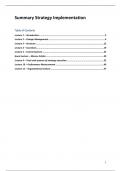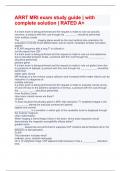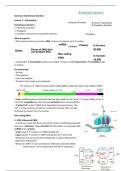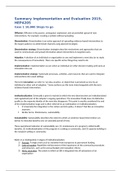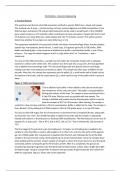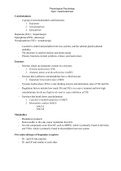Financial Statement Analysis & Valuation
Lecture 1: Valuation drivers
1. Introduction
Firm value: Economic value of the firm is the discounted sum of expected future cash flows.
We aim to find out if economic value is equal to market value with valuation.
Is the market overvaluing or undervaluing it?
Accounting is a language to measure and communicate firm performance.
Financial statement analysis (FSA) is about analyzing a firm’s accounting information to learn about its
true performance.
1.1 Case
At Bronte we have been shorting Gulf Resources on behalf or our clients for most of the last year. It’s
a bromine and industrial salt producer. I knew it was suspect and you could tell of the balance sheet
and the P&L
Inventories Cost of goods sold Sales Net income
0.65 54.38 110.28 30.59
Turned their inventory stock over 169.5 (110.28/0.65) times per years. I can’t imagine how active a
plant would need to be to turn over toxic and dangerous bromine that many times.
Lessons learned from this case:
➢ Understand a firm’s business
➢ Understand how a business maps into numbers
➢ Be able to put the numbers into perspective using industry expertise
➢ Be sure there is a catalyst for the market to reverse its opinion
1.2 Structure
Steps of equity valuation
1. Understanding the past
a. Value drivers
b. Understanding the business
c. Ration analysis
2. Forecasting the future
a. Information collection
b. Forecasting
3. Valuation
a. Equity valuation
b. Capita selection
Understanding the past: understanding a firm’s financials in the context of its business strategy and
the industry and economy it operates in.
➢ Understand the business
o What does the firm make? How is it made? Who buys it?
o Why are competitors, what type of industry if the firm operating in? where is the
industry heading to?
➢ Accounting analysis
o Check how the business is mapped into the numbers
o Do numbers reflect the economics of the business well?
, ➢ Ratio analysis
o Understand key strengths and weaknesses of the firm’s strategy
o Identify key drivers of value
o Spot any irregularities
Forecasting the future: forecasting the firm’s value creating in the future
➢ Information collection
o Based on your understanding of the past, collect information to broaden your view
and inform your predictions
➢ Forecasting
o Framing the forecasting problem using the same ratios as we used for understanding
the past
o Starting with sales, build a structured forecast
o Use pro-forma statements to anchor your valuation inputs and double-check how
reasonable your forecasts are
2. Valuation
2.1 Net present value (NPV)
Q: What is the maximum you are willing to pay for an investment that you expect to yield EUR 100 for
three years while a comparable risky investment is expected to return 8% per year?
𝐶𝐹1 𝐶𝐹2 𝐶𝐹3
𝑉0 = 𝐸0 [ + + ]
(1 + 𝑟)1 (1 + 𝑟)2 (1 + 𝑟)3
1001 100 100
= 𝐸0 [ 1
+ 2
+
(1 + 0.08) (1 + 0.08) (1 + 0.08)3
= 92.59 + 85.73 + 79.38
= 257.71
Between receiving 100 euros every 3 years, or 1 times, now.
2.2 Value
The value of an equity interest is based on the present value of the expected future cash dividends to
be received
P0 is the value of common equity at time 0
DIVt is amount of cash dividend to be paid in period t
r is the discount rate
E0 [.] indicated that what’s inside the brackets is uncertain (i.e., expected values)
2.3 Dividends
The dividend discount formula is rarely used directly
➢ Dividends don’t’ directly reflect performance
➢ Dividends are to a large extent discretionary
➢ Many firms do not pay dividend right now, but promise to pay later
o Dividend irrelevance theorem
o Need to forecast things very far in the future
So, we are not using a dividends based discount model, but a earnings based model.
,2.4 Earnings
Earnings-Based Valuation
Clean surplus accounting. All increases and decreases go
through the income statement.
The price today is a function of 2 things
➢ Common shareholders’ equity (CE), measures at time zero. (this is the past of the firm)
➢ Expectations regarding the future E0[.]
3. Valuation drivers
3.1 Approach
Core Value Drivers
, Structured Approach to Valuation
1. Understanding the past (using financials)
2. Forecasting the future (using financials)
3. Valuation (using financials)
3.2 Profitability (RoE)
Return on equity is the key profitability measure
➢ RoE is the RoI for equity investors
➢ Return on investment (RoI):
𝑒𝑎𝑟𝑛𝑖𝑛𝑔𝑠 𝑓𝑜𝑟 𝑡ℎ𝑒 𝑝𝑒𝑟𝑖𝑜𝑑
𝑅𝑜𝐼 = 𝑖𝑛𝑣𝑒𝑠𝑡𝑚𝑒𝑛𝑡 𝑎𝑡 𝑡ℎ𝑒 𝑏𝑒𝑔𝑖𝑛𝑛𝑖𝑛𝑔 𝑜𝑓 𝑡ℎ𝑒 𝑝𝑒𝑟𝑖𝑜𝑑
‘Good’ RoE?
➢ RoE is the rate of return that equity owners get
➢ RoE must be higher than the opportunity cost (r) in order to generate value
➢ We call these opportunity cost (r) ‘expected return’ or ‘cost of equity capital’
➢ Only if RoE > r does a firm create value
3.3 Investment growth (g)
10% RoE on €100 versus 10% RoE on €1,000,000
➢ Profitability is only part of the picture
➢ Amount of capital invested is crucial too
➢ Investment depreciated and becomes obsolete
o Investment needs to grow to expand the business
o Investment in new assets to not become obsolete and stay competitive
3.4 Risk (r)
Recall the initial NPV example.
Now, let’s assume realized cash flows were EUR 120, EUR 50, and EUR 40, respectively
Period 1 Period 2 Period 3
Expected 100 100 100
Realized 120 50 40
➢ In our NPV calculation, we use expected values; yet, they are uncertain
➢ To adjust for the uncertainty (riskiness) of these expectations, we discount them
➢ r is our measure of this uncertainty
Lecture 1: Valuation drivers
1. Introduction
Firm value: Economic value of the firm is the discounted sum of expected future cash flows.
We aim to find out if economic value is equal to market value with valuation.
Is the market overvaluing or undervaluing it?
Accounting is a language to measure and communicate firm performance.
Financial statement analysis (FSA) is about analyzing a firm’s accounting information to learn about its
true performance.
1.1 Case
At Bronte we have been shorting Gulf Resources on behalf or our clients for most of the last year. It’s
a bromine and industrial salt producer. I knew it was suspect and you could tell of the balance sheet
and the P&L
Inventories Cost of goods sold Sales Net income
0.65 54.38 110.28 30.59
Turned their inventory stock over 169.5 (110.28/0.65) times per years. I can’t imagine how active a
plant would need to be to turn over toxic and dangerous bromine that many times.
Lessons learned from this case:
➢ Understand a firm’s business
➢ Understand how a business maps into numbers
➢ Be able to put the numbers into perspective using industry expertise
➢ Be sure there is a catalyst for the market to reverse its opinion
1.2 Structure
Steps of equity valuation
1. Understanding the past
a. Value drivers
b. Understanding the business
c. Ration analysis
2. Forecasting the future
a. Information collection
b. Forecasting
3. Valuation
a. Equity valuation
b. Capita selection
Understanding the past: understanding a firm’s financials in the context of its business strategy and
the industry and economy it operates in.
➢ Understand the business
o What does the firm make? How is it made? Who buys it?
o Why are competitors, what type of industry if the firm operating in? where is the
industry heading to?
➢ Accounting analysis
o Check how the business is mapped into the numbers
o Do numbers reflect the economics of the business well?
, ➢ Ratio analysis
o Understand key strengths and weaknesses of the firm’s strategy
o Identify key drivers of value
o Spot any irregularities
Forecasting the future: forecasting the firm’s value creating in the future
➢ Information collection
o Based on your understanding of the past, collect information to broaden your view
and inform your predictions
➢ Forecasting
o Framing the forecasting problem using the same ratios as we used for understanding
the past
o Starting with sales, build a structured forecast
o Use pro-forma statements to anchor your valuation inputs and double-check how
reasonable your forecasts are
2. Valuation
2.1 Net present value (NPV)
Q: What is the maximum you are willing to pay for an investment that you expect to yield EUR 100 for
three years while a comparable risky investment is expected to return 8% per year?
𝐶𝐹1 𝐶𝐹2 𝐶𝐹3
𝑉0 = 𝐸0 [ + + ]
(1 + 𝑟)1 (1 + 𝑟)2 (1 + 𝑟)3
1001 100 100
= 𝐸0 [ 1
+ 2
+
(1 + 0.08) (1 + 0.08) (1 + 0.08)3
= 92.59 + 85.73 + 79.38
= 257.71
Between receiving 100 euros every 3 years, or 1 times, now.
2.2 Value
The value of an equity interest is based on the present value of the expected future cash dividends to
be received
P0 is the value of common equity at time 0
DIVt is amount of cash dividend to be paid in period t
r is the discount rate
E0 [.] indicated that what’s inside the brackets is uncertain (i.e., expected values)
2.3 Dividends
The dividend discount formula is rarely used directly
➢ Dividends don’t’ directly reflect performance
➢ Dividends are to a large extent discretionary
➢ Many firms do not pay dividend right now, but promise to pay later
o Dividend irrelevance theorem
o Need to forecast things very far in the future
So, we are not using a dividends based discount model, but a earnings based model.
,2.4 Earnings
Earnings-Based Valuation
Clean surplus accounting. All increases and decreases go
through the income statement.
The price today is a function of 2 things
➢ Common shareholders’ equity (CE), measures at time zero. (this is the past of the firm)
➢ Expectations regarding the future E0[.]
3. Valuation drivers
3.1 Approach
Core Value Drivers
, Structured Approach to Valuation
1. Understanding the past (using financials)
2. Forecasting the future (using financials)
3. Valuation (using financials)
3.2 Profitability (RoE)
Return on equity is the key profitability measure
➢ RoE is the RoI for equity investors
➢ Return on investment (RoI):
𝑒𝑎𝑟𝑛𝑖𝑛𝑔𝑠 𝑓𝑜𝑟 𝑡ℎ𝑒 𝑝𝑒𝑟𝑖𝑜𝑑
𝑅𝑜𝐼 = 𝑖𝑛𝑣𝑒𝑠𝑡𝑚𝑒𝑛𝑡 𝑎𝑡 𝑡ℎ𝑒 𝑏𝑒𝑔𝑖𝑛𝑛𝑖𝑛𝑔 𝑜𝑓 𝑡ℎ𝑒 𝑝𝑒𝑟𝑖𝑜𝑑
‘Good’ RoE?
➢ RoE is the rate of return that equity owners get
➢ RoE must be higher than the opportunity cost (r) in order to generate value
➢ We call these opportunity cost (r) ‘expected return’ or ‘cost of equity capital’
➢ Only if RoE > r does a firm create value
3.3 Investment growth (g)
10% RoE on €100 versus 10% RoE on €1,000,000
➢ Profitability is only part of the picture
➢ Amount of capital invested is crucial too
➢ Investment depreciated and becomes obsolete
o Investment needs to grow to expand the business
o Investment in new assets to not become obsolete and stay competitive
3.4 Risk (r)
Recall the initial NPV example.
Now, let’s assume realized cash flows were EUR 120, EUR 50, and EUR 40, respectively
Period 1 Period 2 Period 3
Expected 100 100 100
Realized 120 50 40
➢ In our NPV calculation, we use expected values; yet, they are uncertain
➢ To adjust for the uncertainty (riskiness) of these expectations, we discount them
➢ r is our measure of this uncertainty

